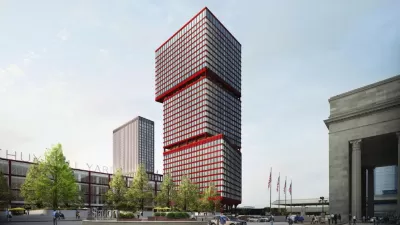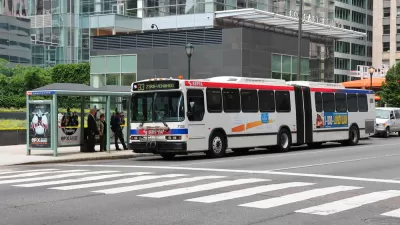The recently rejected proposal for a new Museum of the American Revolution in Philadelphia failed to live up to the spirit of that seminal event, writes Nathaniel Popkin.
Nathaniel Popkin pens a scathing review of architect A.M. Stern’s recently proposed (and subsequently rejected) designs for the city’s new Museum of the American Revolution. In reviewing the building, Popkin does a good job of establishing the difficult dynamics that can arise when designing with a sensitivity to historic context—especially in a city with as rich a history as Philadelphia.
“Since winning the commission, Stern has continuously implied that the only relevant context for the museum is Independence Hall and the few other buildings of its era nearby. This is willful blindness.”
In the end, says Popkin, the proposed brick box design “is a lost chance, in an era of protest, to make the American uprising feel relevant and inspiring today.”
“…Stern's historicism forces us to look backward through the mist of nostalgia to confront our seminal Revolution. This is blatantly dishonest. Not only was the Revolution messy, as Philadelphia's leading historians tell us, but many of its essential questions remain unresolved. In creating a museum to honor that legacy, we mustn't sell ourselves or our city short.”
FULL STORY: Design revolution needed

Trump Administration Could Effectively End Housing Voucher Program
Federal officials are eyeing major cuts to the Section 8 program that helps millions of low-income households pay rent.

Planetizen Federal Action Tracker
A weekly monitor of how Trump’s orders and actions are impacting planners and planning in America.

Ken Jennings Launches Transit Web Series
The Jeopardy champ wants you to ride public transit.

Rebuilding Smarter: How LA County Is Guiding Fire-Ravaged Communities Toward Resilience
Los Angeles County is leading a coordinated effort to help fire-impacted communities rebuild with resilience by providing recovery resources, promoting fire-wise design, and aligning reconstruction with broader sustainability and climate goals.

When Borders Blur: Regional Collaboration in Action
As regional challenges outgrow city boundaries, “When Borders Blur” explores how cross-jurisdictional collaboration can drive smarter, more resilient urban planning, sharing real-world lessons from thriving partnerships across North America.

Philadelphia Is Expanding its Network of Roundabouts
Roundabouts are widely shown to decrease traffic speed, reduce congestion, and improve efficiency.
Urban Design for Planners 1: Software Tools
This six-course series explores essential urban design concepts using open source software and equips planners with the tools they need to participate fully in the urban design process.
Planning for Universal Design
Learn the tools for implementing Universal Design in planning regulations.
Ada County Highway District
Clanton & Associates, Inc.
Jessamine County Fiscal Court
Institute for Housing and Urban Development Studies (IHS)
City of Grandview
Harvard GSD Executive Education
Toledo-Lucas County Plan Commissions
Salt Lake City
NYU Wagner Graduate School of Public Service





























